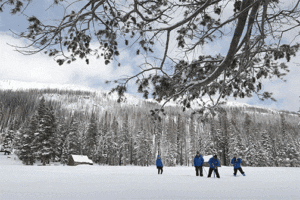With all the rain experienced in the State of California from the recent storms, here is a look at the water levels at our California reservoirs.
According to the California Department of Water Resources, since December 1, Lake Oroville has increased by 77 feet—it now stands at 44% of capacity with its historical average being 81%.
South Delta exports (at Banks Pumping Plan) is occurring at higher levels due to continued storm activity.
Meanwhile, Lake Del Valle storage is forecasted to increase, thus, they are doing flood releases which are required and being coordinated by the USACE.
Snow Survey

Photo by California Department of Water Resources
DWR conducted its first Phillips Station snow survey on Jan. 3. The manual survey recorded 55.5 inches of snow depth and a snow water equivalent of 17.5 inches, which is 177 percent of average for this location. The snow water equivalent measures the amount of water contained in the snowpack and is a key component of DWR’s water supply forecast. Statewide the snowpack is 174 percent of average for this date.
“Big snow totals are always welcome, but we still have a long way to go before the critical April 1 total,” said Sean de Guzman, DWR’s snow surveys and water supply forecasting unit manager. “It’s always great to be above average this early in the season, but we must be resilient and remember what happened last year. If January through March of 2023 turn out to be similar to last year, we would still end the water year in severe drought with only half of an average year’s snowpack.”
On average, the Sierra snowpack supplies about 30 percent of California’s water needs and is an important factor in determining how DWR manages the state’s water resources. Its natural ability to store water is why the Sierra snowpack is often referred to as California’s “frozen reservoir.” A below-average snowpack impacts water users across the state, putting further stress on the environment and critical groundwater supplies. — Full Story

